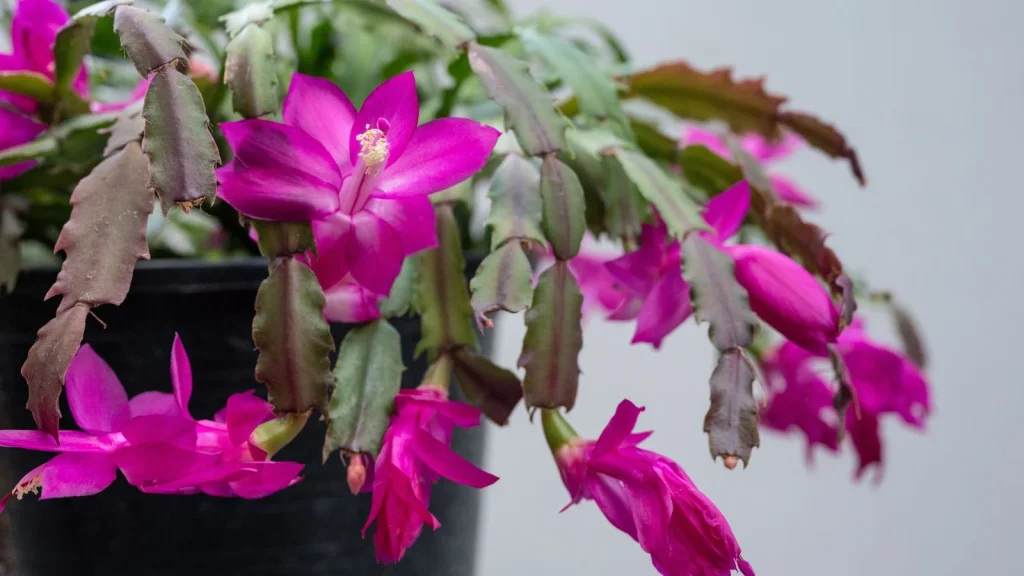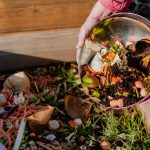Your christmas cactus — a short introduction to this piece.
As we move into November, we see buds developing on our healthy Christmas cactus. They’ll continue to swell for their big, billowy show around the winter holidays. If you have a Thanksgiving cactus, yours is gearing up now for a spectacle of color in red, pink, purple, coral, and white.
Christmas cactus (Schlumbergera x buckleyi) follows Thanksgiving cactus, beginning in December and flowering through January. Easter cactus follows with a winter/early spring display.
The holiday cacti are adaptable houseplants. Even though they’re far from their native mountainous rainforests of Brazil, they adjust to the moderate conditions of our homes. While true cacti, they differ from their desert-dwelling relatives in a preference for humidity and even moisture. Balancing their moisture needs is key to long-lived success (they can live for decades as houseplants).
With seasonal adjustments and moving our tropicals indoors for the winter, we can expect a transition period as they acclimate to fluctuations in the growing environment. Cooler temperatures mean slower growth, less moisture uptake, and less evaporation. We may find ourselves on the side of overwatering, which can lead to a dying Christmas cactus with root rot.
With quick action, it’s possible to reverse the impacts. When it comes to root rot and Christmas cactus, a few steps taken in short order can lead to resiliency and hopefully their blooming glory in the following seasons.
What is Root Rot?
Root rot is a common fungal disease that damages roots and leads to their inability to uptake moisture and nutrients. In Christmas cactus, root rot is often Fusarium, Pythium, and Phytophthora pathogens.
The pathogens infect the roots, which become brown and mushy. As they decay, they can’t function to support upper growth. Without correcting root rot promptly, the Christmas cactus can’t recover.
Causes and Signs of Root Rot

Overwatering happens. It’s easy to make the rounds too often for the lush tropicals, especially as they move inside for the cool season, as temperatures change, or in overcompensating for a lapse in watering. Knowing what to look for in overwatering helps stave off the lasting effects of root rot.
Wilted leaves (phylloclades) in Christmas cactus often indicate watering issues, whether too much or too little. In their native rainforests, the epiphytes absorb moisture from the air. They also experience drenching rains, followed by a dry season. Their roots don’t remain in prolonged saturated or soggy soils.
Cacti in overly wet media with poor airflow may show yellowing in addition to wilting stems, along with stunted growth. Plants appear drought-stressed as the roots fail to deliver moisture and nutrients.
The best way to check if excess moisture is a problem is to touch the soil surface and one to two inches deep. If the composition is damp and sticky (and you didn’t just water), then overwatering is likely the cause of languid stems and reduced vigor.
Another factor of root rot is poor potting media or a container that’s too large. Aged soils or those that lack drainage hold water and suppress oxygen available to the roots. A Christmas cactus in heavy or degraded potting soil is susceptible to rot. In a pot that’s too big for the specimen, extra soil volume holds water.
How to Save Your Christmas Cactus

With saturated soil as an indicator of root rot in Christmas cactus, it’s time to inspect the roots. Gently unpot the cactus and loosen the roots from the potting media. Roots impacted by rot will be brown and soft, rather than healthy white or tan. You may even notice a rotting odor.
To correct Christmas cactus root rot, trim away any brown, decaying roots. Keep as many healthy roots as possible intact. Clipping away the damaged roots limits the spread of the pathogen, preserving the healthy ones that remain. A clean restart is essential to controlling the spread.
Let the unpotted specimen lie in place to dry for several hours before repotting. Keep it out of direct sun, whether indoors or out, in the process. If the majority of roots show rot, the cactus is a loss. Root rot spreads quickly, and nipping the roots in time is key to reversing its effects.
Repot

After pruning away mushy roots and allowing the remaining set to dry, it’s time to repot. Use fresh potting mix to rejuvenate the Christmas cactus. Ensure the container has good drainage holes.
Christmas cactus relies on well-draining soil to thrive. Use a high-quality mix suited for tropicals that’s light and fluffy.
You can also blend your own with:
- One part potting soil
- Two parts coco coir or orchid bark
- One part builder’s sand or perlite
The aim with potting media for Schlumbergera is to retain moisture while promoting drainage and aeration.
Adjust the Watering Regimen

With dry roots safely repotted, give the tropical succulent a thorough watering. Water until it flows out of the drainage holes. Remove any catchment saucers after the pot has time to drain, usually within about 15 minutes. Avoid letting the pot sit in water, as this can lead to excess moisture absorption.
To get on a regular regimen, water when the potting media feels dry one or two inches below the soil surface. This is usually about every seven to 10 days, depending on the growing environment, plant size, container type, and media.
Christmas cactus likes to dry out slightly between waterings, and a soil touch test is the best way to determine readiness. They benefit from moisture in moderation.
Take Cuttings

With the watering regimen and fresh potting mix in place to correct root rot in Christmas cactus, they’ll hopefully recover in time. Just in case, it may be a good idea to take cuttings in the meantime. They propagate easily from stem cuttings, ensuring you’ll have a piece of the original in case it doesn’t rebound.
Each phylloclade segment has the potential to set roots. Clip a segment of the stem and root it in water or in moistened potting media in a small pot. Keep the cuttings in a bright, warm spot out of direct sun as they develop.
Keep Them Potbound

A healthy Christmas cactus can live for years in a single container and seldom needs repotting. They prefer tight quarters and need the stress of slightly crowded roots to produce blooms.
To ensure fresh potting soil and the best growing situation, keep an eye on indicators like halted new growth, lack of budding, bud drop, and withered young stems. You may also see roots protruding from drainage holes or exposed on the surface. Stems may wilt, and the soil will dry out quickly.
The best time to repot a Christmas cactus is just after flowering. Transplanting at other times can affect growth and budding. Refresh the potting mix and opt for a container one inch larger than the existing pot.
Your christmas cactus appears here to highlight key ideas for readers.













